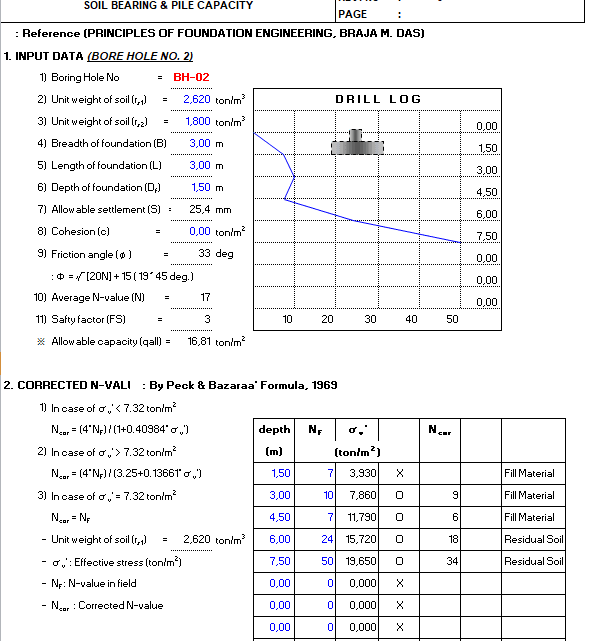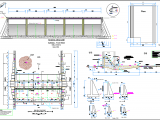
Soil Bearing and Pile Capacity Spreadsheet
30 July 2025Table of Contents
Soil Bearing and Pile Capacity Spreadsheet
Every great structure, from a towering skyscraper to a sprawling bridge, stands on a hidden hero: its foundation. But the foundation itself is only as strong as the ground it rests upon. Understanding the interaction between a structure and the earth is the most critical step in civil engineering.
This is where two fundamental concepts come into play: Soil Bearing Capacity and Pile Capacity.
While they both relate to how much load the ground can support, they are not interchangeable. Misunderstanding their differences can lead to design flaws, budget overruns, and catastrophic failures. This guide will demystify these core principles, clarify their applications, and explain why a proper geotechnical investigation is the best investment you can make in any project.
The Foundation of Foundations: Understanding Soil Bearing Capacity (SBC)
In the simplest terms, Soil Bearing Capacity (SBC) is the maximum pressure that the soil can withstand from a foundation without undergoing shear failure or excessive settlement.
Think of it like this: If you stand on hard concrete, it easily supports your weight. If you stand on soft mud, you sink. The concrete has a high bearing capacity, while the mud has a very low one.
In engineering, we are concerned with two primary types of bearing capacity for these shallow foundations (like strip footings or mat foundations):
-
Ultimate Bearing Capacity (q_u): This is the theoretical maximum pressure that would cause the soil right beneath the foundation to fail completely (a shear failure). We never design for this value.
-
Safe Bearing Capacity (SBC) or Allowable Bearing Capacity (q_a): This is the practical, usable value. It is the Ultimate Bearing Capacity divided by a Factor of Safety (typically between 2.5 and 3). This safety margin accounts for uncertainties in soil conditions, load calculations, and construction methods, ensuring the foundation remains stable with zero risk of shear failure.
What Factors Influence Soil Bearing Capacity?
The ground beneath our feet is not uniform. The SBC can vary dramatically over short distances and is influenced by several key factors:
-
Soil Type: Dense sand, gravel, and hard rock have excellent bearing capacity. Soft clay and loose silt have poor bearing capacity.
-
Water Content: The presence of water is a game-changer. A high water table can significantly reduce the bearing capacity of granular soils and soften clays, weakening them.
-
Soil Density/Compactness: The denser the soil particles are packed, the higher the bearing capacity. This is why soil compaction is a critical step in site preparation.
-
Foundation Depth and Width: Generally, bearing capacity increases with the depth and width of the foundation.
-
Settlement: It’s not just about preventing catastrophic failure. The foundation must also not settle excessively, which could damage the structure over time. Allowable bearing capacity is often governed by the tolerable settlement limit.
Going Deeper: An Introduction to Pile Capacity
What happens when the soil near the surface is weak, like the soft mud in our example? If we can’t place a shallow foundation, we must transfer the building’s load to a stronger, deeper soil layer. This is the job of deep foundations, most commonly, piles.
Pile Capacity is the total load a single pile can support without failing or settling excessively. Unlike a shallow footing which only pushes down on the soil beneath it, a pile transfers its load to the earth in two distinct ways:
-
End Bearing (or Point Bearing): This is the resistance provided by the soil layer at the very bottom tip of the pile. The pile acts like a column, transferring the load directly to a strong layer of rock or very dense sand deep underground.
-
Skin Friction (or Shaft Friction): This is the resistance generated along the entire length of the pile’s shaft as it interacts with the surrounding soil. The friction between the pile’s surface and the soil holds it in place and supports a portion of the load.
The total Pile Capacity is the sum of its End Bearing capacity and its Skin Friction capacity.
The dominance of one over the other depends on the soil profile.
-
End-Bearing Piles: Used when a strong rock or soil layer exists at a reasonable depth. Most of the load is carried by the pile tip.
-
Friction Piles: Used in deep deposits of clay or sand where no hard stratum is reachable. The load is carried almost entirely by the skin friction along the pile’s long shaft.
The Critical Difference: Soil Bearing vs. Pile Capacity at a Glance
To rank well, content needs to be clear and easy to understand. Here is a direct comparison:
| Feature | Soil Bearing Capacity (Shallow Foundations) | Pile Capacity (Deep Foundations) |
| Foundation Type | Spread footings, strip footings, mat/raft foundations. | Piles, piers, caissons. |
| Load Transfer | Load is transferred directly to the soil surface immediately beneath the footing. | Load is transferred through the pile to deeper, stronger soil strata. |
| Mechanism | Entirely through bearing pressure at the base. | A combination of End Bearing at the tip and Skin Friction along the shaft. |
| Application | Used when strong soil is available at a shallow depth (typically < 3 meters). | Used when surface soil is weak, compressible, or has a high water table. |
| Analysis | Based on the properties of the near-surface soil. | Requires analysis of multiple soil layers along the entire length of the pile. |
| Governing Factor | Preventing shear failure and excessive settlement of the surface soil. | Preventing pile structural failure, soil failure at the tip, and pull-out from skin friction. |
Why Geotechnical Investigation is Non-Negotiable
You cannot look at a patch of land and know its bearing capacity. The only way to determine the ground’s properties is through a geotechnical investigation. This process involves drilling boreholes, collecting soil samples, and performing field and lab tests like the Standard Penetration Test (SPT) or Cone Penetration Test (CPT).
For deep foundations, the Pile Load Test is the gold standard. A test pile is driven into the ground and loaded with immense weight to directly measure its capacity and settlement. This provides invaluable, real-world data that validates engineering calculations.
Skipping or skimping on this investigation to “save money” is the most dangerous gamble in construction. It’s like performing surgery without an X-ray.
Conclusion: Building on Knowledge, Not on Assumptions
Soil bearing capacity and pile capacity are the two pillars of foundation design. SBC governs how we build on strong, shallow ground, while pile capacity gives us the tools to safely bypass weak ground and anchor our structures to the strength that lies beneath.
The key takeaway is that every structure’s foundation must be engineered specifically for the ground it will stand on. By respecting the immense forces at play and investing in a thorough geotechnical investigation, we ensure that our creations are not just impressive in their height, but also absolute in their safety and longevity.


